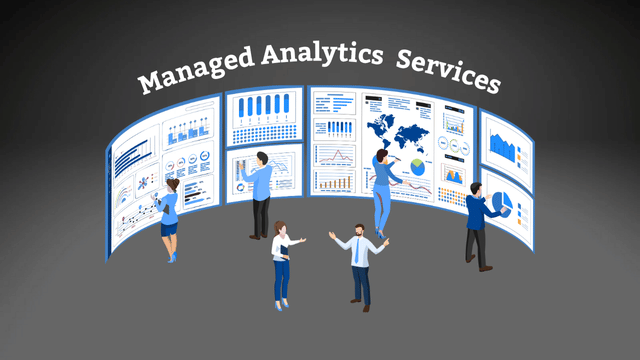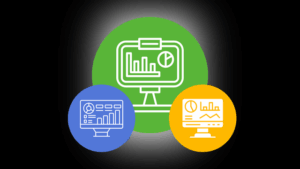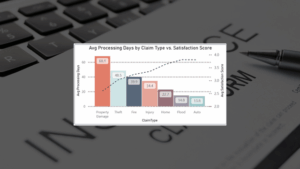Today, most organizations know their data holds value, but few have the right tools, processes, and people in place to effectively access it and act on it. The most common roadblocks? Outdated reports, inconsistent dashboards, and siloed data that slow decision-making and prevent visibility and collaboration across departments.
That’s not surprising, because the truth is, even when companies invest in business intelligence (BI) tools, success is far from guaranteed. Cleaning data, integrating systems, modeling sources, building pipelines, and maintaining reports takes specialized expertise and ongoing upkeep—more than most businesses can realistically manage alone.
Managed analytics services provide a full-service approach to analytics. You can think of it like getting an enterprise-class data team (including data strategists, engineers, modelers, and report authors) without having to hire and manage a full-time, in-house team. And the approach is flexible. Whether you need help building your very first dashboard or scaling a mature analytics program, managed analytics services give you the foundation, firepower, and flexibility to get more value from your data.
In this post, we walk through what managed analytics services include, how to know if your organization is ready for it, and what benefits you can expect when you make the move.
What You Can Expect from Managed Analytics Services
Managed analytics services go beyond short-term consulting. Unlike most BI projects, which typically end after a limited-scope engagement, a partner in managed data analytics gives you ongoing support, working as an extension of your team to design, build, and evolve a scalable analytics solution tailored to your business’s unique needs.
Here’s a closer look at what you can expect from managed analytics services:
1. Data Assessment and Strategy Planning
Before any data is moved, modeled, or visualized, data analytics managed services should always begin with a clear understanding of where you are today.
That means doing a deep-dive assessment of your organization’s current systems, pain points, and goals to identify gaps in your data ecosystem, uncover opportunities, and align stakeholders around a unified roadmap for improvement.
Most importantly, this assessment should prioritize what’s most valuable for your business, whether that’s executive reporting, compliance tracking, or operational performance.
Not exactly sure what role data analytics can play in your business? Explore our Data Stories to see how other organizations are solving real-world challenges with data analytics, no matter the industry.
2. Data Integration and Pipeline Development
In most organizations, data often lives in many different places, such as your CRMs, ERPs, Excel sheets, marketing tools, billing systems, and more.
To break down silos and gain meaningful insights into day-to-day operations, a managed analytics provider will build automated data pipelines, connecting diverse sources and transforming inputs as needed to extract, unify, and standardize your data for analysis.
During this process, it’s essential to ensure secure, reliable data integration that can scale. Without pipelines carefully optimized for efficiency and accuracy, you risk delays in reporting and inconsistent outputs—gaps that can lead to decisions based on wrong information.
3. Centralized Data Storage and Management
Once data is extracted and transformed, it needs to live in secure, scalable infrastructure.
Typically, a managed analytics service provider will set up a cloud-based data warehouse or lakehouse to store and organize your structured and semi-structured data in one unified location.
For example, a provider may suggest Azure Data Warehouse or Snowflake, depending on your organization’s size, budget, and data complexity. This central repository becomes your organization’s single source of truth, a go-to environment where both technical and business teams can turn for consistent reporting, accurate insights, and collaborative decision-making.
This is a key pillar of managed analytics services. Without centralized storage, your data can be fragmented, duplicated, or otherwise difficult to manage. The data warehouse is the foundation that enables accurate reporting, auditing, and cross-functional insights to scale and adapt as your business grows.
Curious about what’s under the hood of enterprise analytics? Tune into our podcast, More Than Reports, to learn more about data warehouses.
4. Ongoing Data Quality Monitoring
It may be well organized and centralized, but data is ultimately pointless if you can’t trust it for strategic decision-making. That’s why ongoing data quality monitoring is an essential component of managed analytics services.
After initial integration, the next step is to implement automated checks and validation rules so your data pipeline can catch missing fields, unexpected values, duplicate records, or other anomalies that deviate from expectations—before they end up in downstream reports.
Proactive monitoring is vital for maintaining data integrity—but strangely, many organizations don’t give it enough attention. According to a great expectations survey of 500 data technology professionals, 91% said data quality issues negatively impact operations; yet, only 23% named data quality as a company-wide focus.
A managed analytics provider can help your organization embed a layer of oversight to ensure every report your team views is built on trusted, consistent data.
5. Interactive Dashboards
Dashboards are where analytics come to life, giving both business and technical teams a space to visualize, explore, and interpret data to drive better decisions. But often, these dashboards are cluttered, inconsistent, and disconnected from real business priorities, making it difficult for users to find answers and act on real-time performance data.
A managed analytics provider can ensure dashboards are clean and purposeful so you can confidently rely on them for reporting, forecasting, and other strategic planning.
Crucially, that means designing dashboards that reflect the context of your real-life business questions—not just abstract data snapshots. For example, if you’re an insurance provider trying to understand why claim turnaround times have slowed, then you might segment by adjuster, region, or claim type to uncover root causes. This way, you can quickly pinpoint bottlenecks and take targeted action to improve operational efficiency.
Think dashboards are just plug and play? Discover why off-the-shelf dashboards aren’t enough to power data-driven cultures—and what you can gain from custom business intelligence.
5 Signs You're Ready for Managed Data Analytics
Not every business needs managed analytics services right away. But readiness often reveals itself in everyday inefficiencies.
If your team is spending too much time wrangling data (and not enough time using it) or your reporting fails to keep pace with business needs, then a managed analytics service provider may be the solution you’ve been missing
Here’s how to know if it’s time to explore data analytics managed services:
1. You’re Drowning in Spreadsheets and Manual Reporting
If pulling a report means logging into five different platforms, merging spreadsheets, and emailing around final versions, you’re working against your data—not with it.
And you’re not alone. According to an Adobe Acrobat survey, 48% of professionals struggle to find documents quickly and efficiently. For smaller organizations, the problem is even more pronounced: Another survey from Act! reports that 45% of SMBs still rely on paper records for customer, contact, and vendor data. Worse, 11% have no system in place at all.
This kind of inefficiency not only slows down decision-making—it also drains time, energy, and confidence from your team.
2. Your Data Lives in Too Many Disconnected Systems
It’s incredibly common for organizations to rely on a mix of platforms, such as CRMs, ERPs, spreadsheets, billing tools, marketing software, and much more. But when these systems aren’t connected, your data can become inconsistent, fragmented, and difficult to access.
Consider: According to the IBM Data Differentiator, 82% of enterprises say silos disrupt their critical workflows. Even more concerning, 68% of enterprise data remains unanalyzed—an unfortunate result if data is too difficult to find, consolidate, or trust.
Without a centralized system and a structured approach to analytics and reporting, data remains scattered, error-prone, and slow to deliver value. Managed analytics services solve this problem by unifying your data sources and automating the flow of information across systems—so your team can spend less time wrangling spreadsheets and more time using it to make informed decisions.
3. You Lack the In-House Expertise to Build a Scalable Data Stack
Building a modern analytics solution requires more than just tools. You also need the combined expertise of diverse specialists, like data engineers, architects, analysts, and BI developers, who understand how to design, integrate, and support a scalable stack.
Though vital to long-term analytics maturity, these skills can often be hard to find. According to mthree’s Diversity in Tech Report, 47% of businesses report “substantial skills gaps in data science.” As data volumes grow and demand increases, even organizations with strong IT teams can struggle to attract and retain specialized talent in data modeling, pipeline automation, and real-time reporting.
Managed analytics services mean you can access that expertise on demand, without the burden of sourcing, hiring, and managing full-time, in-house employees.
4. You’ve Tried to Build Reports, But They’re Always Late or Inaccurate
If your reporting process involves chasing down spreadsheets or waiting on a busy analyst, then you’re likely missing out on opportunities to act quickly with your data.
That’s because manual reporting simply doesn’t scale. Without the right infrastructure in place, reports can be outdated by the time they’re delivered, forcing teams to waste valuable hours reconciling conflicting numbers instead of acting on insights. Over time, teams may eventually lose trust in data and stop relying on it altogether.
By building automated pipelines and embedding continuous data quality monitoring, a managed analytics partner can streamline reporting to ensure accurate, up-to-date reports that drive confident decisions.
Want to understand why reporting tools alone aren’t enough? Read Understanding the Role of Reporting Software in Analytics.
5. You’ve Outgrown Your Current Tools
What once worked well (e.g., Excel spreadsheets, out-of-the-box reports, or lightweight dashboards) may end up holding your organization back over time. It’s a natural progression; as your data volume grows, so too do your complexity and reporting needs.
Unfortunately, many organizations get stuck in legacy tools and never let themselves evolve. Instead, they’ll find themselves patching together workarounds just to keep up, leaving them with slow performance, disconnected reports, and unreliable outputs that can stall and even break under pressure.
This limits both speed and scale. But managed analytics services can help you move beyond those limitations. Whether that’s implementing a cloud data warehouse, establishing governing practices, or automating cross-functional reporting, an experienced partner can choose the right architecture that’s built to grow with your business and adapt to changing needs—today and tomorrow.
With Managed Analytics, There Are Numerous Benefits
Done right, managed analytics services do more than deliver reports; it fundamentally reshapes how your business engages with data.
By centralizing your infrastructure and automating routine processes, these services enable your team to operate with greater confidence, speed, and impact.
Here’s what that transformation can look like:
1. Improved Data Accuracy and Consistency
Without a dedicated team responsible for data stewardship, that leaves every department in your organization responsible for managing its own metrics, filters, or definitions. When that happens, it’s only a matter of time before dashboards become misaligned and tell conflicting stories. Down the line, these reporting discrepancies lead to confusion, rework, and loss of confidence in data—a real shame when you consider how heavily today’s businesses rely on accurate, timely reporting to stay competitive.
But with a managed analytics provider creating a single source of truth that’s consistent, reliable, and centrally governed, your organization can count on consistent, trustworthy data that aligns teams, speeds up decision-making, and lets your team move forward with confidence.
2. Faster Time-to-Insight
When data lives across multiple platforms and reports are built manually, insights move at the speed of your team’s availability, not your business’s needs. Unfortunately, this often means that by the time a report is compiled, reviewed, and circulated, its data is already outdated—and the moment to act has already passed.
Managed analytics services accelerate insight by automating data refreshes, report generation, and delivery. Rather than waiting days (or weeks) for updates, stakeholders can get the answers they need to make decisions at the click of a button, saving time, reducing lag, and minimizing missed opportunities.
Look at Audibel, for example. Before partnering with LeapFrogBI, the healthcare organization was reliant on static, canned reports. This left them slow to react, limited in visibility, and disconnected from day-to-day performance. Now, with an end-to-end BI solution, they receive timely, custom reports that align with KPIs to effectively monitor marketing and operational efforts and take corrective action when it matters most.
Read more about the impact of Audibel and LeapFrogBI’s 7-year partnership.
3. More Time for Strategic Focus
Too often, analysts and decision-makers spend more time building reports than interpreting them. They lose hours to formatting spreadsheets, troubleshooting errors, and manually cobbling together data from disparate systems. All this effort robs time that could be better spent on meaningful analysis.
Managed analytics services give you that time back. With automation and streamlined data delivery, your team can shift from data janitors to strategic thinkers. In other words, instead of cleaning and compiling data, they can focus on spotting trends, testing hypotheses, and making proactive, insight-driven decisions.
For example, at Marsh & McLennan Agency – Southwest, LeapFrogBI helped eliminate more than 8,000 hours of manual work by delivering an automated reporting infrastructure. With routine reporting automated, that time can be reinvested into higher-value work for better service delivery.
4. Scalability Without Rebuilding
When it comes to analytics, most organizations start small: simple dashboards, ad hoc reports, or lightweight BI tools. These one-off solutions may work for a while, but as data volume, user needs, and business complexity grows, Band Aid solutions usually begin to break—and become liabilities that stall growth.
By investing in managed analytics services, you can skip this growing pain altogether. A seasoned provider who knows enterprise architecture and scalable analytics design can build a long-term, scalable solution for your organization that scales with growth and adapts to change—without duplicated effort, fragile workarounds, or costly rebuilds.
Platinum Dermatology Partners experienced this challenge firsthand. As the organization was undergoing fast expansion and acquiring new practices, data became fragmented and hard to manage. LeapFrogBI created a solution to unify data across 15 different systems, delivering an extensive suite of business-focused reports and dashboards to improve decision-making and operational visibility. The result? A 20% increase in collections and faster, data-driven decisions across the board.
Learn more about how LeapFrogBI helped future-proof the analytics infrastructure at Platinum Dermatology Partners.
5. Greater Cost-Efficiency
There’s no two ways about it: Building a full-suite analytics team in-house is expensive—and time-consuming. Between recruiting, onboarding, and retaining talent, such as data engineers, analysts, and BI developers, you can expect a significant investment in both salaries and software.
For context: On average, the salary for a data analytics engineer in the U.S. is $129,700/year—and that doesn’t include benefits or other incentives.
And salaries aren’t the whole story. According to one estimate, small to mid-sized companies can expect to spend between $10,000 and $100,000 per year on data analytics costs, including tools and training. Still, that spend doesn’t always yield ROI when team bandwidth, limited expertise, or inefficient tool setups get in the way.
Managed analytic services offer a smarter (and more cost-efficient) approach. You get access to a full data team and enterprise-grade infrastructure—without bearing the costs of hiring, training, or maintaining those skills and systems internally. Instead, you just pay for what you need, when you need—maximizing value while minimizing overhead.
Worried About Outsourcing Analytics? Let’s Clear Things Up
Still not sure if managed analytics is the right fit?
Outsourcing any part of your business can be nerve-wracking, especially when it comes to something as sensitive and strategic as data. But in practice, managed analytics services offer more transparency, flexibility, and control than most expect.
These are some of the most common objections—and why they don’t hold up:
“We’ll Lose Control Over Our Data”
With the right partner, outsourcing data analytics actually gives you more control—not less. You define the metrics, access, and logic that matter to your business. Nothing happens in a black box, and you’re never locked out of your own systems.
In fact, centralized reporting makes your data more visible and easier to access for collaboration and decision-making so your teams can work from the same source of truth and act quickly with confidence.
“Outsourcing Will Be Too Expensive”
In reality, managed analytics services are often more affordable than in-house data teams.
Building an internal team with full-stack analytics capabilities is a massive investment—and it’s harder (and more expensive) to scale. In contrast, outsourcing data analytics gives you access to enterprise-class skills and infrastructure at a fraction of the cost.
You only pay for what you use, and you avoid the overhead of hiring, training, and retaining specialized talent.
“Our Data Is Too Complex or Messy”
Complexity is exactly why these services exist. Without a strong data foundation, it’s hard for teams to make sense of and draw insights from disparate data. But a qualified partner can integrate, clean, and standardize even the most tangled datasets.
You don’t need perfect data to get started with managed analytics services—just a willingness to improve and iterate.
“We’ve Tried Before and It Didn’t Stick”
In many cases, analytics projects fail due to misalignment—not because the data lacked potential. That doesn’t mean the effort isn’t worth trying again.
With the right strategy, infrastructure, and partner, managed analytics can become an embedded, everyday part of how your business operates and makes decisions.
Turn Your Data Challenges Into Wins with LeapFrogBI
Your business may have systems in place to collect and store data—but is that data actually helping you drive results?
Without a clear strategy, robust infrastructure, and specialized expertise, most data analytics efforts stall out in disconnected systems, manual reporting, and incomplete dashboards that can’t support timely, confident decisions.
Instead of spinning your wheels with inconsistent reporting, you can move forward with clarity and control with LeapFrogBI’s managed analytics services.
We give you when-you-need-it access to a full-service, expert data team who can design, build, and manage a custom, scalable solution that supports your unique business goals—not just a generic template.
Whether you’re just starting to centralize reporting and need help launching your first dashboard or you’ve outgrown your current setup and need to scale, we can design a solution to help you unlock real, day-to-day value from your data.
You won’t just get better dashboards. You’ll get a system that adapts, scales, and delivers actionable insight consistently.
Ready to learn more about what you can achieve with the right data analytics foundation? Learn more about LeapFrogBI’s Managed Analytics Services.
Frequently Asked Questions
How do managed analytics differ from traditional business intelligence services?
Traditional BI services often focus on one-off deliverables, like building reports or dashboards. Managed analytics services, on the other hand, are an ongoing partnership that includes strategy, engineering, integration, support, and evolution. Where traditional BI can be project-based and transactional, managed analytics services are designed for long-term impact.
What kind of companies typically use managed analytics?
The best candidates for managed analytics services are companies that want to leverage data for better decision-making but lack the resources, time, or specialized expertise to do it in-house. Outsourcing data analytics is particularly advantageous for small to mid-sized businesses that need enterprise-grade capabilities without the overhead of an internal team.
How much input will our internal team have?
As much as you want. Your internal team defines goals, metrics, and access preferences. From there, we build the supporting infrastructure to deliver a custom solution. At LeapFrogBI, our managed analytics services are collaborative by design so you stay in control—without overloading internal resources.
How long does it take to implement managed analytics services?
You don’t need to wait months to see results. Many organizations that implement managed analytics services can launch their first reporting solution in just a few weeks and then expand functionality over time. Timelines depend on your goals and current data maturity, but at LeapFrogBI, our clients typically see 10X ROI within 6 months.








